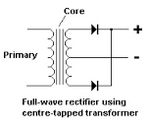jit_singh_tara
Full Member level 6
- Joined
- Dec 22, 2006
- Messages
- 325
- Helped
- 9
- Reputation
- 18
- Reaction score
- 4
- Trophy points
- 1,298
- Location
- Delhi , India
- Activity points
- 4,293
Dear Friends ,
I am using 7-0-7 transformer rated 150mA .
I am generating 2 supplies :
1.5V regulated power supply .
2.8V unregulated power supply.
Drawing 140 mA from the ckt.
I am drawing 140 mA from the ckt . My transformer is heating . I am afraid that by using 7-0-7 transformer i am using only half of the secondary winding that way i am trying to pull 140mA from the 75mA winding . Please suggest if i am right .
PLease let me know the difference between efficiency of normal transformer and centre tapped transformer .
I am using 7-0-7 transformer rated 150mA .
I am generating 2 supplies :
1.5V regulated power supply .
2.8V unregulated power supply.
Drawing 140 mA from the ckt.
I am drawing 140 mA from the ckt . My transformer is heating . I am afraid that by using 7-0-7 transformer i am using only half of the secondary winding that way i am trying to pull 140mA from the 75mA winding . Please suggest if i am right .
PLease let me know the difference between efficiency of normal transformer and centre tapped transformer .
